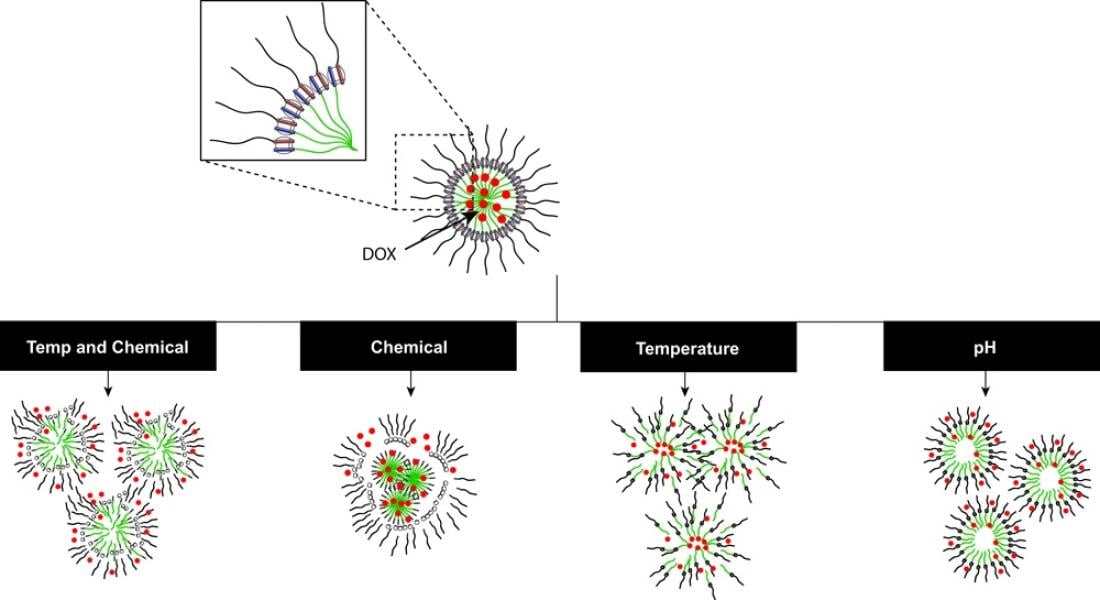Schematic of the cucurbituril-based micelle and how it reacts to different stimuli
Singapore, 02 March 2012 – Dr Loh Xian Jun, a researcher from A*STAR’s Institute of Materials Research and Engineering (IMRE), was recently elected a Fellow of the University of Cambridge’s Fitzwilliam College. Some of the College’s very notable alumni include Nobel Prize winner Albert Szent-Györgyi, who discovered Vitamin C and Singapore's first Prime Minister, Mr Lee Kuan Yew, who is an honorary Fellow at the college. Dr Loh is also a Visiting Professor at the Melville Laboratory for Polymer Synthesis in the Department of Chemistry, University of Cambridge, where his study on the anti-cancer smart biomaterials is being done.
Dr Loh is developing an anti-cancer biomaterial drug delivery system that limits collateral damage to healthy cells during cancer treatment. Made up of tiny multi-stimuli responsive exploding bubble-like micelles, these anti-cancer smart ‘bombs’ can be guided to their target to release chemotherapeutic drugs, just like how today’s precision munitions work. The main difference here is that Dr Loh’s anti-cancer smart ‘bombs’ can differentiate friend from foe, and explode only at sites with cancerous cells, limiting damage to healthy cells.
“Cancer cells have characteristics which differentiate them from normal cells. For example, the interior of a cancer cell is more acidic and is chemically different compared to normal cells,” explained Dr Loh. “By exploiting these properties, I designed capsules which can more accurately target suspected cancer tumour sites,” said Dr Loh, adding that his cucurbituril-based biomaterial is more stable and is able to better form single, discrete drug-carrying parcels than other drug delivery systems such as currently available cyclodextrin-based biomaterials.
Dr Loh is currently doing post-doctoral work at the University of Cambridge under the A*STAR Graduate Scholarship. “Joining Fitzwilliam College has been a very humbling and exciting appointment that has given me the opportunity to be part of the unique pedagogic faculty at Cambridge. Together with my research experiences, this exposure has enabled me to gain personal insight into the eclectic and vibrant culture here,” said Dr Loh.
Dr Loh was awarded the Singapore National Science Talent Search (NSTS) Merit Award in 1999 and the NSTS / NSS (BS) Scholarship in 2002. He completed his Bachelor degree in Applied Chemistry at National University of Singapore (NUS) with First Class Honours in 2006. After a research attachment at IMRE, he went on to pursue his PhD studies under the A*STAR Graduate Scholarship in 2007. Following the completion of his PhD studies in Dec 2009, he was deployed to IMRE. He was awarded the A*STAR Graduate Scholarship (Postdoctoral Fellowship) in Oct 2010 to pursue post-doctoral training at Cambridge.
--------------------------------------------
For media enquiries, please contact:
Mr Eugene Low
Manager, Corporate Communications
for Institute of Materials Research and Engineering (IMRE)
3, Research Link
Singapore 117602
DID +65 6874 8491
Mobile +65 9230 9235
Email [email protected]
For technical enquiries, please contact:
Dr Loh Xian Jun
University of Cambridge
Department of Chemistry
Melville Lab for Polymer Synthesis
Lensfield Road, Cambridge CB2 1EW
United Kingdom
E-mail: [email protected]
________________________________________
Annex A – A*STAR Corporate Profiles
About the Institute of Materials Research and Engineering (IMRE)
The Institute of Materials Research and Engineering (IMRE) is a research institute of the Agency for Science, Technology and Research (A*STAR). The Institute has capabilities in materials analysis & characterisation, design & growth, patterning & fabrication, and synthesis & integration. We house a range of state-of-the-art equipment for materials research including development, processing and characterisation. IMRE conducts a wide range of research, which includes novel materials for organic solar cells, photovoltaics, printed electronics, catalysis, bio-mimetics, microfluidics, quantum dots, heterostructures, sustainable materials, atom technology, etc. We collaborate actively with other research institutes, universities, public bodies, and a wide spectrum of industrial companies, both globally and locally.
About the Agency for Science, Technology and Research (A*STAR)
The Agency for Science, Technology and Research (A*STAR) is the lead agency for fostering world-class scientific research and talent for a vibrant knowledge-based and innovation-driven Singapore. A*STAR oversees 14 biomedical sciences and physical sciences and engineering research institutes, and six consortia & centres, located in Biopolis and Fusionopolis as well as their immediate vicinity.
A*STAR supports Singapore's key economic clusters by providing intellectual, human and industrial capital to its partners in industry. It also supports extramural research in the universities, hospitals, research centres, and with other local and international partners.
---------------------------------------------
Annex B – More information on the anti-cancer smart bombs
Dr Loh Xian Jun’s research on “Triply Triggered Doxorubicin Release From Supramolecular
Nanocontainers” uses cucurbituril-based biomaterials for a drug delivery system that is being studied for applications in anti-cancer treatment.
Cucurbituril acts like a ‘handcuff’ that holds two polymer chains together simply by mixing the polymer components and cucurbituril in water. At low temperatures, the entire polymer is water-soluble. When the temperature is raised, one part of this construct becomes water-repellent and the polymer self-organizes itself to form a capsule. The interior environment of this capsule is suitable for the encapsulation of hydrophobic drugs. These drug-loaded capsules can carry the drugs through the body to the designated target cells. The micelles are stimuli-responsive and tailored to react to certain environmental factors. When the pH becomes acidic as in the cancer cells, the outer layer of the micelle becomes charged and the capsule swells up. It can then be made to ‘explode’ in the presence of a chemical trigger to release the chemotherapeutic drug, thus killing only the cancer cells but not the surrounding healthy cells.
Reference: Xian Jun Loh, Jesús del Barrio, Pearl Pei Chern Toh, Tung-Chun Lee, Dezhi Jiao, Urs Rauwald, Eric A. Appel, and Oren A. Scherman, “Triply Triggered Doxorubicin Release From Supramolecular Nanocontainers”, Biomacromolecules, 2012, 13 (1), pp 84–91, DOI: 10.1021/bm201588m



